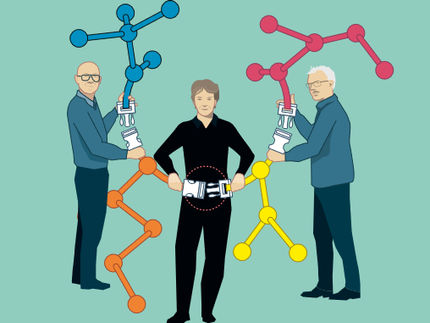Nature inspires first artificial molecular pump
Simple design mimics pumping mechanism of life-sustaining proteins found in living cells
Using nature for inspiration, a team of Northwestern University scientists is the first to develop an entirely artificial molecular pump, in which molecules pump other molecules. This tiny machine is no small feat. The pump one day might be used to power other molecular machines, such as artificial muscles.
The new machine mimics the pumping mechanism of life-sustaining proteins that move small molecules around living cells to metabolize and store energy from food. For its food, the artificial pump draws power from chemical reactions, driving molecules step-by-step from a low-energy state to a high-energy state - far away from equilibrium.
While nature has had billions of years to perfect its complex molecular machinery, modern science is only beginning to scratch the surface of what might be possible in tomorrow's world.
"Our molecular pump is radical chemistry - an ingenious way of transferring energy from molecule to molecule, the way nature does," said Sir Fraser Stoddart, the senior author of the study. Stoddart is the Board of Trustees Professor of Chemistry in Northwestern's Weinberg College of Arts and Sciences.
"All living organisms, including humans, must continuously transport and redistribute molecules around their cells, using vital carrier proteins," he said. "We are trying to recreate the actions of these proteins using relatively simple small molecules we make in the laboratory."
Chuyang Cheng, a fourth-year graduate student in Stoddart's laboratory and first author of the paper, has spent his Ph.D. studies researching molecules that mimic nature's biochemical machinery. He first designed an artificial pump two years ago, but it required more than a year of testing prototypes before he found the ideal chemical structure.
"In some respects, we are asking the molecules to behave in a way that they would not do normally," Cheng said. "It is much like trying to push two magnets together. The ring-shaped molecules we work with repel one another under normal circumstances. The artificial pump is able to syphon off some of the energy that changes hands during a chemical reaction and uses it to push the rings together."
The tiny molecular machine threads the rings around a nanoscopic chain - a sort of axle - and squeezes the rings together, with only a few nanometers separating them. At present, the artificial molecular pump is able to force only two rings together, but the researchers believe it won't be long before they can extend its operation to tens of rings and store more energy.
Stoddart's team has been researching artificial molecular machines for several years. A challenge they have faced for a long time is how to power their machines. This latest advance may allow them to make machines that perform tasks at the molecular level.
Compared to nature's system, the artificial pump is very simple, but it is a start, the researchers say. They have designed a novel system, using kinetic barriers, that allows molecules to flow "uphill" energetically.
"This is non-equilibrium chemistry, moving molecules far away from their minimum energy state, which is essential to life," said Paul R. McGonigal, an author of the study. "Conducting non-equilibrium chemistry in this way, with simple artificial molecules, is one of the major challenges for science in the 21st century."
Ultimately, they intend to use the energy stored in their pump to power artificial muscles and other molecular machines. The researchers also hope their design will inspire other chemists working in non-equilibrium chemistry.
"This is completely unlike the process of designing the machinery we are used to seeing in everyday life," Stoddart said. "In a way, one must learn to see things from the molecules' point of view, considering forces such as random thermal motion that one would never consider when building an agricultural water pump or any other mechanical device."
Original publication
"An Artificial Molecular Pump."; Nature Nanotechnology.
Most read news
Original publication
"An Artificial Molecular Pump."; Nature Nanotechnology.
Organizations
Other news from the department science

Get the chemical industry in your inbox
By submitting this form you agree that LUMITOS AG will send you the newsletter(s) selected above by email. Your data will not be passed on to third parties. Your data will be stored and processed in accordance with our data protection regulations. LUMITOS may contact you by email for the purpose of advertising or market and opinion surveys. You can revoke your consent at any time without giving reasons to LUMITOS AG, Ernst-Augustin-Str. 2, 12489 Berlin, Germany or by e-mail at revoke@lumitos.com with effect for the future. In addition, each email contains a link to unsubscribe from the corresponding newsletter.


























































